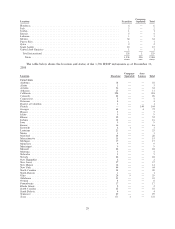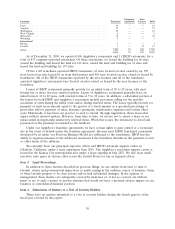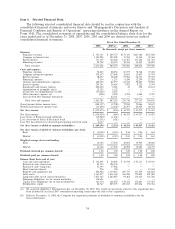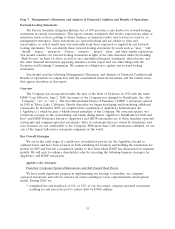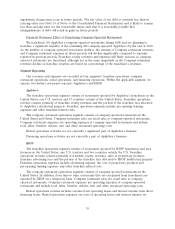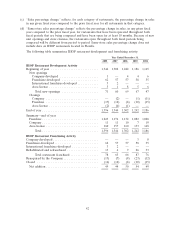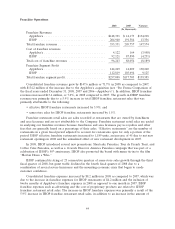IHOP 2008 Annual Report Download - page 53
Download and view the complete annual report
Please find page 53 of the 2008 IHOP annual report below. You can navigate through the pages in the report by either clicking on the pages listed below, or by using the keyword search tool below to find specific information within the annual report.
impairment charges may occur in future periods. The fair value of our debt is currently less than its
carrying value (see Note 14 of Notes to the Consolidated Financial Statements) and is likely to remain
less than carrying value for the foreseeable future such that it is reasonably possible that
extinguishments of debt will result in gains in future periods.
Financial Statement Effect of Franchising Company-Operated Restaurants
We franchised 103 Applebee’s company-operated restaurants during 2008 and are planning to
franchise a significant majority of the remaining 406 company-operated Applebee’s by the end of 2010.
As the number of company-operated restaurants declines, the amount of Company restaurant revenues
and Company restaurant expenses in future periods will decline significantly compared to amounts
reported in previous periods. Franchise royalty revenues and expenses will likely increase as company-
operated restaurants are franchised, although not in the same magnitude as the Company restaurant
revenues decline as franchise royalties are based on a percentage of the franchisee’s revenues.
Segment Reporting
Our revenues and expenses are recorded in four segments: franchise operations, company
restaurant operations, rental operations, and financing operations. Within the applicable segment, we
operate two distinct restaurant concepts: Applebee’s and IHOP.
Applebee’s
The franchise operations segment consists of restaurants operated by Applebee’s franchisees in the
United States, one U.S. territory and 15 countries outside of the United States. Franchise operations
revenue consists primarily of franchise royalty revenues and the portion of the franchise fees allocated
to Applebee’s intellectual property. Franchise operations expenses include pre-opening training
expenses and other franchise-related costs.
The company restaurant operations segment consists of company-operated restaurants in the
United States and China. Company restaurant sales are retail sales at company-operated restaurants.
Company restaurant expenses are operating expenses at company-operated restaurants and include
food, labor, benefits, utilities, rent and other restaurant operating costs.
Rental operations activities are not currently a significant part of Applebee’s business.
Financing operations activities are not currently a part of Applebee’s business.
IHOP
The franchise operations segment consists of restaurants operated by IHOP franchisees and area
licensees in the United States, one U.S. territory and two countries outside the U.S. Franchise
operations revenue consists primarily of franchise royalty revenues, sales of proprietary products,
franchise advertising fees and the portion of the franchise fees allocated to IHOP intellectual property.
Franchise operations expenses include advertising expense, the cost of proprietary products and
pre-opening training expenses and other franchise-related costs.
The company restaurant operations segment consists of company-operated restaurants in the
United States. In addition, from time to time, restaurants that are reacquired from franchisees are
operated by IHOP on a temporary basis. Company restaurant sales are retail sales at company-
operated restaurants. Company restaurant expenses are operating expenses at company-operated
restaurants and include food, labor, benefits, utilities, rent and other restaurant operating costs.
Rental operations revenue includes revenue from operating leases and interest income from direct
financing leases. Rental operations expenses are costs of operating leases and interest expense on
39


